A belay device is an essential piece of rock climbing equipment and often one of the first pieces of gear acquired by new climbers. Climbers today have a bounty of belay devices to choose from, ranging from traditional tube-style devices to more modern assisted-braking devices. While many of the devices on the market share similar characteristics—namely catching falling climbers—there are a number of features that distinguish one device from another.
Keep reading if you’re wondering what the right belay device is for you as we examine the pros and cons of some of the most popular belay devices on the wall, at the crag, and in the gym.

Black Diamond ATC
 Black Diamond released the original Air Traffic Controller—better known as the ATC—three decades ago. Over its approximately thirty-year life, the ATC has undergone relatively few changes, most notably shedding some weight and spawning different versions like the ATC-XP which features high-friction grooves for more stopping power and the ATC Guide (more on that soon).
Black Diamond released the original Air Traffic Controller—better known as the ATC—three decades ago. Over its approximately thirty-year life, the ATC has undergone relatively few changes, most notably shedding some weight and spawning different versions like the ATC-XP which features high-friction grooves for more stopping power and the ATC Guide (more on that soon).
Pros: The ATC’s long history and universality have helped make it one of the most affordable and widely available belay devices. The Black Diamond ATC’s straightforward design makes it easy to use, familiar to the majority of climbers, and simple to double-check before climbing.
The ATC works with ropes between 7.7mm and 11mm, works with both single and double ropes, and accommodates two strands of rope for rappelling, making it a favorite for a variety of climbing disciplines ranging from the gym to single-pitch and from rock to ice.
Cons: The downside of the Black Diamond ATC is that it’s not as well suited for multi-pitch climbs as other options because it doesn’t have an assisted-braking feature for belaying a seconding climber off the anchor. It is also harder to use as an improvised ascender.
Black Diamond ATC Guide
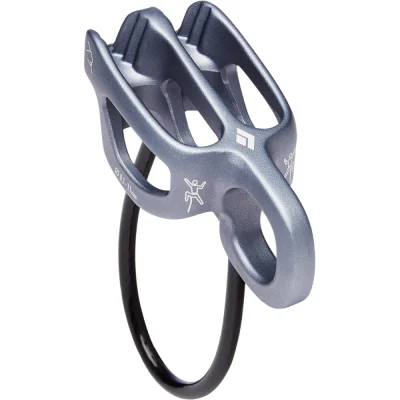 The ATC Guide was released a little over a decade after the original ATC, bringing multi-pitch functionality to otherwise tried-and-true belay devices. Black Diamond subsequently added an Alpine Guide version that is lighter, more compact, and handles skinnier ropes—between 6.9mm and 9mm.
The ATC Guide was released a little over a decade after the original ATC, bringing multi-pitch functionality to otherwise tried-and-true belay devices. Black Diamond subsequently added an Alpine Guide version that is lighter, more compact, and handles skinnier ropes—between 6.9mm and 9mm.
Pros: In everyday operation, the ATC Guide operates similarly to the original ATC for standard belays, making it simple to use and easy to double to check. The ATC Guide handles a wide variety of ropes (from 8.1mm to 11mm); works with both singles and doubles; accommodates double-rope rappels; and is equally at home on rock and ice.
Where the ATC Guide shines is in multi-pitch settings—for example, climbs like the West Chimney of the Eaglet—thanks to its ability to catch the falls of seconding climbers with its assisted braking function when in “guide mode” (i.e., belaying directly off the anchor). As the name suggests, this is also a super-popular device for climbing guides.
Cons: It’s hard to find much at fault with the ATC Guide—it’s an incredibly versatile device that works admirably across a broad spectrum of climbing styles. If there was a knock, it’s the lack of assisted braking when belaying off a harness, which isn’t ideal if you’re belaying someone working a route or have a less-than-great belayer.
Black Diamond ATC Pilot
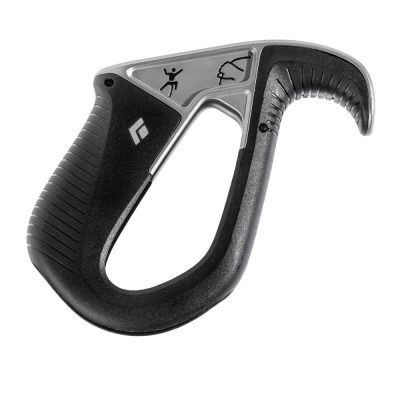 The Black Diamond ATC Pilot is one of the more recent and unique additions to the ATC family.
The Black Diamond ATC Pilot is one of the more recent and unique additions to the ATC family.
Pros: The ATC Pilot is a “passive” assisted-locking device that provides more security both belaying a leader and top-roping than other types of ATCs. The Pilot pinches the rope between the belay carabiner and the device itself when the rope is weighted—helping to ensure safe catches and ease holding a lead climber while they work routes. The Pilot operates similarly to traditional tube-style belay devices and transitioning to using one is straightforward for most climbers.
The ATC Pilot is not right-hand dominant like many other assisted-braking belay devices—meaning righties and lefties are equally comfortable using the device. It accommodates ropes between 8.7mm and 10.5mm.
Cons: The downside of the ATC Pilot is that it’s a bit of a one-trick pony. While it excels on both rock and ice for belaying a leader and top-roping, its functionality is otherwise quite limited (especially in the multi-pitch environment). The Pilot only accommodates a single strand of rope, is not meant for belaying from above, and is not intended for rappelling.
Petzl Reverso
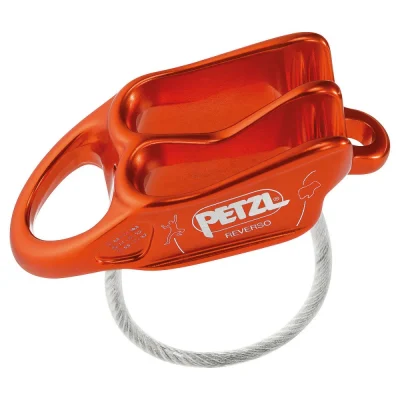 The Petzl Reverso is similar in function to the Black Diamond ATC Guide and has been a staple on the harnesses of multi-pitch climbers for years. Petzl also makes the Verso, a tube-style device that functions similarly to the ATC and ATC-XP.
The Petzl Reverso is similar in function to the Black Diamond ATC Guide and has been a staple on the harnesses of multi-pitch climbers for years. Petzl also makes the Verso, a tube-style device that functions similarly to the ATC and ATC-XP.
Pros: The Petzl Reverso is an extremely versatile piece of climbing gear, it works excellently in both single- and multi-pitch scenarios, on rock and ice, and with single and double ropes. The Reverso provides assisted braking when belaying a second directly off the anchor.
The most notable differences between the Reverso and the ATC Guide are that the Reverso is slightly lighter (57g vs 80g) and the hole used to release the assisted braking is slightly larger. Put another way, the Reverso costs slightly less energy to lug up a wall, although perhaps at the expense of longevity, and is easier to lower a climber when the device is in guide mode but at the expense of some holding power in single-pitch situations.
Cons: Like the Black Diamond ATC Guide, the biggest knock against the Petzl Reverso is its lack of assisted braking when belaying off the harness. Otherwise, the Petzl Reverso is a welcome addition to most climbers’ kits.
Petzl GriGri
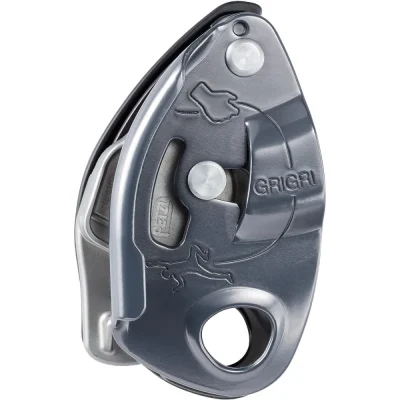 Named after an African good-luck charm, the Petzl GriGri was introduced in 1991 and has become far and away the most popular assisted-braking belay device and a fixture at crags across the world.
Named after an African good-luck charm, the Petzl GriGri was introduced in 1991 and has become far and away the most popular assisted-braking belay device and a fixture at crags across the world.
Pros: The Petzl GriGri offers outstanding performance in single-pitch environments ranging from top roping at the gym to sport climbing at crags like Rumney and is a favorite of both novice and experienced belayers. The most notable attribute of the GriGri is its cam-assisted braking, which makes climbers safer from things like inattentive belayers or accidents involving their belayers—for example, a belayer tripping on the ground and taking their hands off the rope or getting hit by a falling object, like a loose rock. The cam-assisted braking feature of the GriGri also allows it to excel when belaying projecting climbers, as it requires significantly less effort to hold hanging climbers.
The Petzl GriGri only works with a single strand of rope, but it accommodates a wide range of ropes, from 8.5mm to 11mm. It’s a good option for belaying multi-pitch climbs, particularly with a fast second. The GriGri is also a popular tool for hauling, rescuing, self-belaying, and ascending the rope.
Cons: The GriGri isn’t without its flaws. While top rope belaying is fairly straightforward, belaying a leader with a GriGri is tricky and takes some practice, especially when compared to other options listed above. GriGris are also comparatively bulky and expensive. And, in a multi-pitch environment, you’ll need a different device for rappelling if you want to do a traditional two-strand rappel.
Climbing Technology Alpine-Up
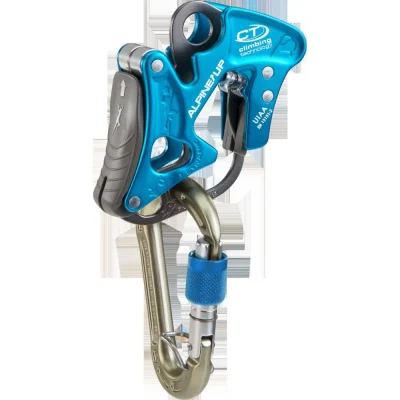 The Climbing Technology Alpine-Up is likely the least-known belay device on this list, however, it offers some unique advantages—and drawbacks—from the other devices.
The Climbing Technology Alpine-Up is likely the least-known belay device on this list, however, it offers some unique advantages—and drawbacks—from the other devices.
Pros: The Climbing Technology Alpine-Up provides climbers with an abundance of versatility thanks to its three modes:
Dynamic: manual braking like an ATC or Verso
Click-up: assisted braking like a GriGri
Guide: assisted braking while belaying from the anchors of a multi-pitch climb (or top-down scenario) like an ATC Guide or Reverso
It’s not only the variety of modes that make the Alpine-Up stand out, the device also works with single, double, and half ropes.
Cons: The downside of all the functionality of the Alpine-Up is that it’s more complicated to use than other belay devices and climbers will want to spend some time familiarizing themselves with the device before putting it into practice. The Alpine-Up also brings to mind the phrase Jack of all trades, master of none and although the Alpine-Up can handle a variety of ropes and climbing scenarios, it doesn’t always do so as smoothly as more specialized devices.
Do you have a belay device you love (or hate) to use that we haven’t listed? If so, tell us why it never leaves your harness—or why it’s buried at the back of your gear closet—in the comments!
Tim Peck and Doug Martland
Tim and Doug met long ago at the Eastern Mountain Sports in Canton, Massachusetts. Bonding over a love of slick Quincy Quarry granite, White Mountain sufferfests, and scheming up adventures while folding tee-shirts, today Tim and Doug collaborate to write about their favorite outdoor activities and occasionally get nostalgic about tee-shirt tables.




